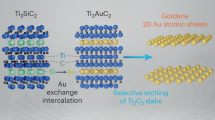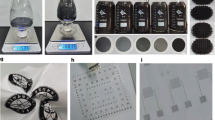Abstract
Integration of individual two-dimensional graphene sheets1,2,3 into macroscopic structures is essential for the application of graphene. A series of graphene-based composites4,5,6 and macroscopic structures7,8,9,10,11 have been recently fabricated using chemically derived graphene sheets. However, these composites and structures suffer from poor electrical conductivity because of the low quality and/or high inter-sheet junction contact resistance of the chemically derived graphene sheets. Here we report the direct synthesis of three-dimensional foam-like graphene macrostructures, which we call graphene foams (GFs), by template-directed chemical vapour deposition. A GF consists of an interconnected flexible network of graphene as the fast transport channel of charge carriers for high electrical conductivity. Even with a GF loading as low as ∼0.5 wt%, GF/poly(dimethyl siloxane) composites show a very high electrical conductivity of ∼10 S cm−1, which is ∼6 orders of magnitude higher than chemically derived graphene-based composites4. Using this unique network structure and the outstanding electrical and mechanical properties of GFs, as an example, we demonstrate the great potential of GF/poly(dimethyl siloxane) composites for flexible, foldable and stretchable conductors12.
This is a preview of subscription content, access via your institution
Access options
Subscribe to this journal
Receive 12 print issues and online access
$259.00 per year
only $21.58 per issue
Buy this article
- Purchase on Springer Link
- Instant access to full article PDF
Prices may be subject to local taxes which are calculated during checkout




Similar content being viewed by others
References
Geim, A. K. & Novoselov, K. S. The rise of graphene. Nature Mater. 6, 183–191 (2007).
Novoselov, K. S. et al. Electric field effect in atomically thin carbon films. Science 306, 666–669 (2004).
Geim, A. K. Graphene: Status and prospects. Science 324, 1530–1534 (2009).
Stankovich, S. et al. Graphene-based composite materials. Nature 442, 282–286 (2006).
Ramanathan, T. et al. Functionalized graphene sheets for polymer nanocomposites. Nature Nanotech. 3, 327–331 (2008).
Ansari, S., Kelarakis, A., Estevez, L. & Giannelis, E. P. Oriented arrays of graphene in a polymer matrix by in situ reduction of graphite oxide nanosheets. Small 6, 205–209 (2010).
Dikin, D. A. et al. Preparation and characterization of graphene oxide paper. Nature 448, 457–460 (2007).
Eda, G., Fanchini, G. & Chhowalla, M. Large-area ultrathin films of reduced graphene oxide as a transparent and flexible electronic material. Nature Nanotech. 3, 270–274 (2008).
Li, X. L. et al. Highly conducting graphene sheets and Langmuir–Blodgett films. Nature Nanotech. 3, 538–542 (2008).
Xu, Y., Sheng, K., Li, C. & Shi, G. Self-assembled graphene hydrogel via a one-step hydrothermal process. ACS Nano 4, 4324–4330 (2010).
Lee, S. H. et al. Three-dimensional self-assembly of graphene oxide platelets into mechanically flexible macroporous carbon films. Angew. Chem. Int. Ed. 49, 10084–10088 (2010).
Rogers, J. A., Someya, T. & Huang, Y. G. Materials and mechanics for stretchable electronics. Science 327, 1603–1607 (2010).
Novoselov, K. S. et al. Two-dimensional gas of massless Dirac fermions in graphene. Nature 438, 197–200 (2005).
Zhang, Y., Tan, Y-W., Stormer, H. L. & Kim, P. Experimental observation of the quantum Hall effect and Berry’s phase in graphene. Nature 438, 201–204 (2005).
Balandin, A. A. et al. Superior thermal conductivity of single-layer graphene. Nano Lett. 8, 902–907 (2008).
Lee, C., Wei, X. D., Kysar, J. W. & Hone, J. Measurement of the elastic properties and intrinsic strength of monolayer graphene. Science 321, 385–388 (2008).
Berger, C. et al. Electronic confinement and coherence in patterned epitaxial graphene. Science 312, 1191–1196 (2006).
Sutter, P. W., Flege, J. I. & Sutter, E. A. Epitaxial graphene on ruthenium. Nature Mater. 7, 406–411 (2008).
Park, S. & Ruoff, R. S. Chemical methods for the production of graphenes. Nature Nanotech. 4, 217–224 (2009).
Hernandez, Y. et al. High-yield production of graphene by liquid-phase exfoliation of graphite. Nature Nanotech. 3, 563–568 (2008).
Yu, Q. K. et al. Graphene segregated on Ni surfaces and transferred to insulators. Appl. Phys. Lett. 93, 113103 (2008).
Chae, S. J. et al. Synthesis of large-area graphene layers on poly-nickel substrate by chemical vapour deposition: Wrinkle formation. Adv. Mater. 21, 2328–2333 (2009).
Reina, A. et al. Large area, few-layer graphene films on arbitrary substrates by chemical vapour deposition. Nano Lett. 9, 30–35 (2009).
Kim, K. S. et al. Large-scale pattern growth of graphene films for stretchable transparent electrodes. Nature 457, 706–710 (2009).
Li, X. S. et al. Large-area synthesis of high-quality and uniform graphene films on copper foils. Science 324, 1312–1314 (2009).
Bae, S. et al. Roll-to-roll production of 30-inch graphene films for transparent electrodes. Nature Nanotech. 5, 574–578 (2010).
Futaba, D. N. et al. Shape-engineerable and highly densely packed single-walled carbon nanotubes and their application as super-capacitor electrodes. Nature Mater. 5, 987–994 (2006).
Ferrari, A. C. et al. Raman spectrum of graphene and graphene layers. Phys. Rev. Lett. 97, 187401 (2006).
Sekitani, T. et al. A rubberlike stretchable active matrix using elastic conductors. Science 321, 1468–1472 (2008).
Jung, Y. J. et al. Aligned carbon nanotube–polymer hybrid architectures for diverse flexible electronic applications. Nano Lett. 6, 413–418 (2006).
Acknowledgements
We thank L. Ma for assisting in large-size graphene foam synthesis and discussions. This work was supported by the National Science Foundation of China (Nos 50921004, 50972147 and 50872136) and Chinese Academy of Sciences (No. KJCX2-YW-231).
Author information
Authors and Affiliations
Contributions
H-M.C. and W.R. proposed and supervised the project, W.R. and Z.C. designed the experiments, Z.C. carried out experiments, W.R., Z.C. and H-M.C. analysed data and wrote the manuscript, L.G. advised on the growth, B.L. made TEM measurements and S.P. helped with conductivity measurements. All the authors participated in discussions of the research.
Corresponding author
Ethics declarations
Competing interests
The authors declare no competing financial interests.
Supplementary information
Supplementary Information
Supplementary Information (PDF 1885 kb)
Rights and permissions
About this article
Cite this article
Chen, Z., Ren, W., Gao, L. et al. Three-dimensional flexible and conductive interconnected graphene networks grown by chemical vapour deposition. Nature Mater 10, 424–428 (2011). https://doi.org/10.1038/nmat3001
Received:
Accepted:
Published:
Issue Date:
DOI: https://doi.org/10.1038/nmat3001
This article is cited by
-
Progress and prospects of graphene-based materials in lithium batteries
Rare Metals (2024)
-
Highly Stable, Stretchable, and Sensitive Strain Sensor Based on a New Type of Elastic Fiber
Fibers and Polymers (2024)
-
Hydrothermally synthesised highly stable binary ZnNbS composite with carbon nanotubes to enhance the redox active sites in energy storage devices
Applied Physics A (2024)
-
Synergistic effect of woven copper wires with graphene foams for high thermal conductivity of carbon fiber/epoxy composites
Advanced Composites and Hybrid Materials (2024)
-
Specific Surface Area Versus Adsorptive Capacity: an Application View of 3D Graphene-Based Materials for the Removal of Emerging Water Pollutants
Water, Air, & Soil Pollution (2023)



